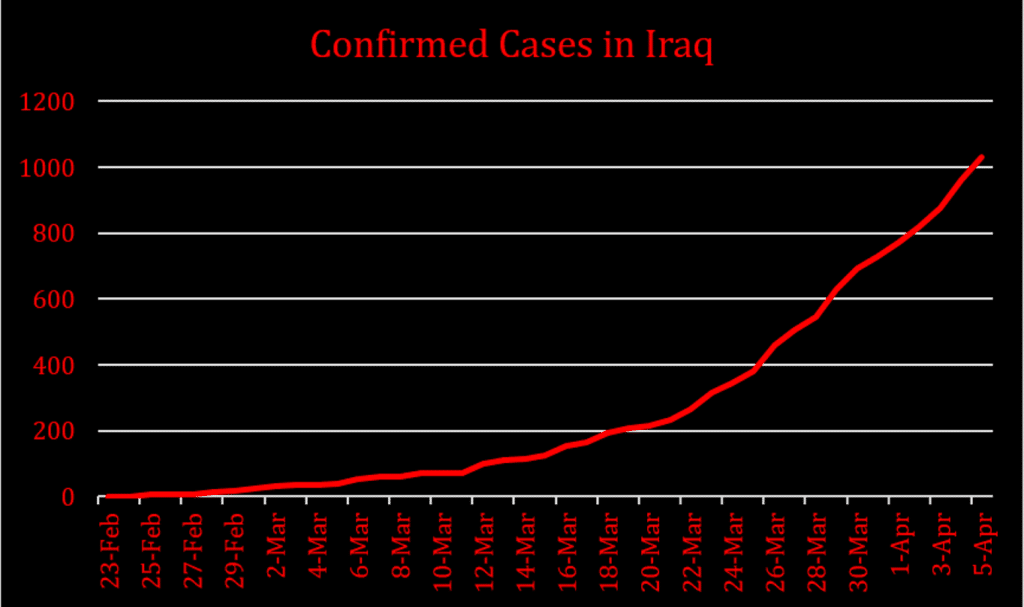April 6, 2020 | Policy Brief
COVID-19 in Iraq
April 6, 2020 | Policy Brief
COVID-19 in Iraq
The timing of the COVID-19 outbreak in Iraq has been particularly unfortunate, arriving concurrently with several other major crises, including a collapse in world oil prices, the absence of a functioning Iraqi government, and an escalating military conflict between the United States and Iran. These intensifying political, economic, security, and public health challenges are now converging, placing enormous strains on an already fragile Iraqi state.
Situation Overview
As of April 6, Iraq has reported 1,031 cases and 64 deaths. Iraq’s first cases have been traced to Iran, the pandemic’s regional epicenter. Two-way traffic between the neighbors is large, as they share a long border and deep political, economic, and religious ties. Millions of Iranian Shiite pilgrims visit Iraqi holy sites annually. Several Iraqi travelers returning from pilgrimages to shrines in Syria have also tested positive for coronavirus.
The actual number of cases in Iraq is almost certainly many times higher than has been officially reported – though the reason for this discrepancy remains controversial. Reuters reported that Iraq was purposefully concealing the true number to avoid mass panic, and that Iraq’s actual number of cases could be more than ten times higher. The government denied this claim, suspended the outlet’s reporting license, and fined it more than $20,000.
While urging Iraq not to limit press freedoms, the UN mission in Iraq issued a statement claiming that the World Health Organization (WHO), which was closely monitoring Iraqi labs, “dismisses the prospect that the government is deliberately hiding or falsifying the results.” Instead, the WHO explained that significant underreporting of cases was the result of “fear, cultural issues including stigmatization, undocumented asymptomatic patients, lack of active surveillance and limited testing.”
According to the WHO, Iraq has recently opened several new COVID-19 labs and is now conducting 4,500 tests per day, compared to about 100 per day a few weeks ago. Accordingly, the WHO predicts that Iraq’s number of confirmed cases will escalate sharply in the first half of April.
By mid-March, Iraq imposed strict social distancing measures, including a 24-hour nationwide curfew that has been extended on multiple occasions. Enforcement has at times proven challenging. On March 20, hundreds of thousands of pilgrims, many probably from Iran, defied the government’s orders by converging on a Shiite shrine in Baghdad.
COVID-19 in the Greater Middle East
| Country | Cases |
| Iran | 60,500 |
| Turkey | 30,217 |
| Israel | 8,611 |
| Pakistan | 3,766 |
| Saudi Arabia | 2,523 |
| UAE | 2,076 |
| Qatar | 1,832 |
| Algeria | 1,423 |
| Egypt | 1,173 |
| Morocco | 1,120 |
| Iraq | 1,031 |
| Bahrain | 756 |
| Kuwait | 665 |
| Tunisia | 574 |
| Lebanon | 541 |
| Afghanistan | 367 |
| Jordan | 349 |
| Oman | 331 |
| W. Bank & Gaza | 253 |
| Syria | 19 |
| Libya | 18 |
| Sudan | 12 |
| Somalia | 7 |
| Yemen | 0 |
Source: JHU Coronavirus Resource Center.
Data current as of 5:00 PM, April 6, 2020.
Implications
Even before the pandemic, Iraq’s healthcare system was in a chronic state of decay, suffering from decades of underinvestment, corruption, and neglect. It could easily be overwhelmed. The health minister’s plea for an emergency allocation of $5 million allegedly went unanswered by Iraq’s caretaker government, compelling the ministry to seek charitable donations for additional resources.
The pandemic’s economic consequences, including the shutdown of the private-sector economy, promises to dramatically exacerbate the hardships faced by average Iraqis. Oil sales cover 90 percent of the government’s budget and 60 percent of GDP. The collapse in oil prices, caused by massive loss of global demand and a Saudi-Russian price war, has already cut monthly revenues in half, making it nearly impossible for the government to buttress an almost non-existent social safety net.
Months before anyone heard of COVID-19, Iraq had been wracked by a mass protest movement demanding better services and jobs and rejecting the legitimacy of Iraq’s corrupt and incompetent post-2003 governing establishment. The protests brought down the prime minister, who has yet to be replaced, leaving the country devoid of political leadership at a moment of acute national crisis. Though the protests have subsided for now in the face of the virus’ onslaught, the risks of large-scale unrest and even collapse will likely return as Iraq’s public health, economic, and political challenges intensify and compound each other.
What to Watch for
If, against all odds, Iraq’s fractured political class can quickly establish a new government with a strong mandate to counteract the pandemic’s social and economic fallout, the country’s descent might be slowed. Timely international assistance on a relatively large scale, though unlikely, might also help alleviate the dire situation. The United States and China have both already made commitments to aid Iraq’s coronavirus response.
Meanwhile, Iran, acting through its militia proxies, has recently escalated its attacks and threats against U.S. military, diplomatic, and oil-related facilities. The eruption of a much larger U.S.-Iran armed conflict could supercharge Iraq’s further destabilization.
John Hannah is senior counselor at the Foundation for Defense of Democracies (FDD), where he also contributes to FDD’s Center on Military and Political Power (CMPP). For more analysis from John and CMPP, please subscribe HERE. Follow FDD on Twitter @FDD and @FDD_CMPP. FDD is a Washington, DC-based, nonpartisan research institute focusing on national security and foreign policy.
